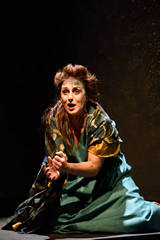| Opera Reviews | 8 May 2024 |
Bel canto shines through the preposterous plot
|
|
| Donizetti: Pia de' Tolomei English Touring Opera April 2016 |
|
|
Elena Xanthoudakis has a voice that fits the eponymous Pia and Donizetti’s melodic lines like a silken glove. It is bright, clear and lithe. As Luciano Botelho discloses his suspicions to Nello, his voice even sounds sly and insinuating. Grant Doyle, on the other hand, is a robust, direct Nello, incredulous at such betrayal, which he feels dishonours him. The wheels are in motion. The ‘secret lover’ is, of course, none other than Rodrigo, and the programme notes set out the arguments for including his prison aria, which is beautifully sung from a very cramped position by Catherine Carby. It is also one of the more preposterous moments of the plot as, on being sprung from the dungeon, she doesn’t immediately run for it, but hangs around to keep singing. Loren Elstein’s set is rather angular and abstract, looking like the back of the set for something else, with flat grey surfaces, metal struts and supports. That, and the dark grey and black quasi-medieval costumes throw the more colourfully-dressed principals into focus; Ghino in frogged, Victorian-style frock-coat, Nello in green jerkin over breast-plate, Pia in long, green gown. And, of course, it throws the focus on the singing. The choral singing is strong and expressive, with the chorus opening Act 2 particularly effective – the Guelphs swearing to annihilate the Ghibellines while wrapping themselves in their flag. Equally effective is the men’s chorus of flagellants and Piotr Lempa’s hermit Piero pointing out the error of Nello’s treatment of Pia. In response, Doyle’s portrayal of Nello’s despair is deeply moving. Meanwhile, Ghino has succumbed to Pia’s pleading and realised the awful wrong he has done. As he sets out his new plans, Botelho’s voice loses its sly, spiteful tone and gains warmth. He hastens to the Ghibelline camp, but is fatally injured en route, resulting in a somewhat melodramatic dying confession to Nello. But Nello has left instructions for Pia to be killed at dawn, unless he sends word. Time is running out and, for the first time, Guy Hoare lights a few faces with the first warm rays of dawn. Then Pia, waking, is flooded with the same warm light, even as she, unwittingly, drinks the poison left for her. At least her husband is there for the end, and so is her brother, so she makes them join hands with her dying breath. John Andrews conducts orchestra, chorus and ensemble with panache and precision. The point of bel canto opera is that it does what it says on the tin; the plot may be preposterous, but the canto must be bel. And that is exactly what director James Conway has delivered for English Touring Opera.
|
|
| Text ©
Catriona Graham Photo © Jane Hobson |

 Pia de’ Tolomei is an everyday love triangle of opposing factions, sibling relations, jealousy and spite. Pia, a Guelph is married to Ghibelline Nello, who has captured her brother Rodrigo. Meanwhile, Nello’s brother Ghino fancies Pia and takes her rejection of his advances as evidence of a secret lover, so seeks to discredit her with her husband.
Pia de’ Tolomei is an everyday love triangle of opposing factions, sibling relations, jealousy and spite. Pia, a Guelph is married to Ghibelline Nello, who has captured her brother Rodrigo. Meanwhile, Nello’s brother Ghino fancies Pia and takes her rejection of his advances as evidence of a secret lover, so seeks to discredit her with her husband.






